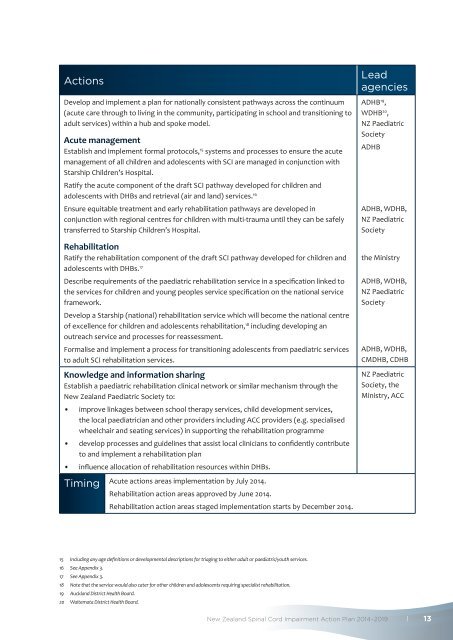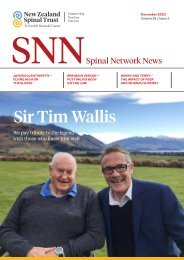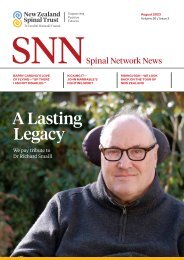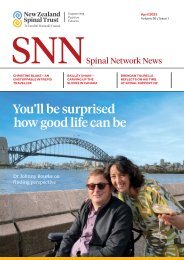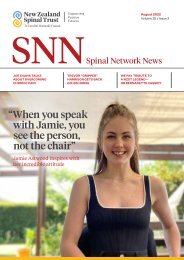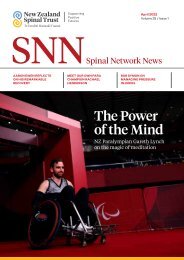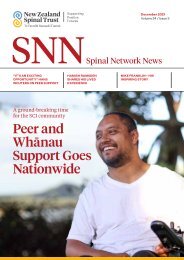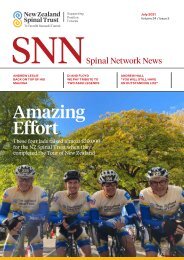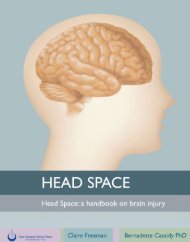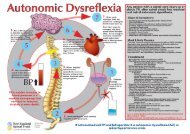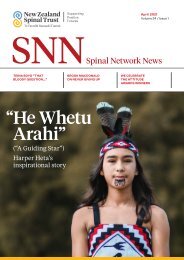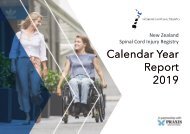SCI Action Plan 2014-2019
You also want an ePaper? Increase the reach of your titles
YUMPU automatically turns print PDFs into web optimized ePapers that Google loves.
<strong>Action</strong>s<br />
Develop and implement a plan for nationally consistent pathways across the continuum<br />
(acute care through to living in the community, participating in school and transitioning to<br />
adult services) within a hub and spoke model.<br />
Acute management<br />
Establish and implement formal protocols, 15 systems and processes to ensure the acute<br />
management of all children and adolescents with <strong>SCI</strong> are managed in conjunction with<br />
Starship Children’s Hospital.<br />
Ratify the acute component of the draft <strong>SCI</strong> pathway developed for children and<br />
adolescents with DHBs and retrieval (air and land) services. 16<br />
Ensure equitable treatment and early rehabilitation pathways are developed in<br />
conjunction with regional centres for children with multi-trauma until they can be safely<br />
transferred to Starship Children’s Hospital.<br />
Rehabilitation<br />
Ratify the rehabilitation component of the draft <strong>SCI</strong> pathway developed for children and<br />
adolescents with DHBs. 17<br />
Describe requirements of the paediatric rehabilitation service in a specification linked to<br />
the services for children and young peoples service specification on the national service<br />
framework.<br />
Develop a Starship (national) rehabilitation service which will become the national centre<br />
of excellence for children and adolescents rehabilitation, 18 including developing an<br />
outreach service and processes for reassessment.<br />
Formalise and implement a process for transitioning adolescents from paediatric services<br />
to adult <strong>SCI</strong> rehabilitation services.<br />
Knowledge and information sharing<br />
Establish a paediatric rehabilitation clinical network or similar mechanism through the<br />
New Zealand Paediatric Society to:<br />
• improve linkages between school therapy services, child development services,<br />
the local paediatrician and other providers including ACC providers (e.g. specialised<br />
wheelchair and seating services) in supporting the rehabilitation programme<br />
• develop processes and guidelines that assist local clinicians to confidently contribute<br />
to and implement a rehabilitation plan<br />
• influence allocation of rehabilitation resources within DHBs.<br />
Timing<br />
Acute actions areas implementation by July <strong>2014</strong>.<br />
Rehabilitation action areas approved by June <strong>2014</strong>.<br />
Rehabilitation action areas staged implementation starts by December <strong>2014</strong>.<br />
Lead<br />
agencies<br />
ADHB 19 ,<br />
WDHB 20 ,<br />
NZ Paediatric<br />
Society<br />
ADHB<br />
ADHB, WDHB,<br />
NZ Paediatric<br />
Society<br />
the Ministry<br />
ADHB, WDHB,<br />
NZ Paediatric<br />
Society<br />
ADHB, WDHB,<br />
CMDHB, CDHB<br />
NZ Paediatric<br />
Society, the<br />
Ministry, ACC<br />
15 Including any age definitions or developmental descriptions for triaging to either adult or paediatric/youth services.<br />
16 See Appendix 3.<br />
17 See Appendix 3.<br />
18 Note that the service would also cater for other children and adolescents requiring specialist rehabilitation.<br />
19 Auckland District Health Board.<br />
20 Waitemata District Health Board.<br />
New Zealand Spinal Cord Impairment <strong>Action</strong> <strong>Plan</strong> <strong>2014</strong>–<strong>2019</strong><br />
I<br />
13


